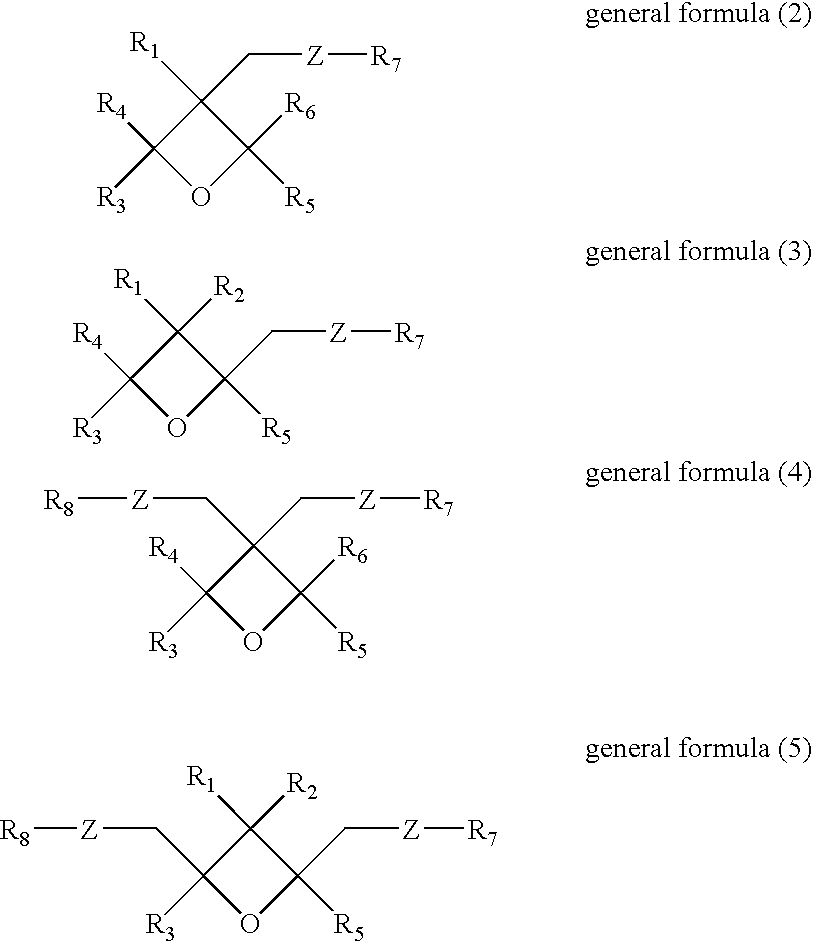Ink composition
- Summary
- Abstract
- Description
- Claims
- Application Information
AI Technical Summary
Benefits of technology
Problems solved by technology
Method used
Image
Examples
examples
Preparation of Pigment Dispersion
[0203] According to the following method, there was prepared each of the following yellow, magenta, cyan and black pigment dispersions 1. In this respect, each dispersion was prepared using a known dispersion device while appropriately adjusting the dispersion conditions in such a manner that the average particle size of each pigment dispersion fell within the range of from 0.2 to 0.3 μm and then filtered through a filter with heating to thus give each corresponding pigment dispersion.
(Yellow Pigment Dispersion 1)Amt. (partComponentby weight)C.I. Pigment Yellow 1210Polymeric dispersant (Solsperse series,5available from Zeneca Company)Stearyl acrylate85
[0204]
(Magenta Pigment Dispersion 1)Amt. (partComponentby weight)C.I. Pigment Red 57:115Polymeric dispersant (Solsperse series,5available from Zeneca Company)Stearyl acrylate80
[0205]
(Cyan Pigment Dispersion 1)Amt. (partComponentby weight)C.I. Pigment Blue 15:320Polymeric dispersant (Solsperse series...
examples 2 to 5
Preparation of Inks
[0215] Magenta inks 2 to 5 were prepared according to the method described below:
(Magenta Ink 2)Amt. (partComponentby weight)Magenta Pigment Dispersion 1201,6-Hexanediol diacrylate60Di-functional aromatic urethane acrylate specified below5(Molecular weight (Mw): 1500)Hexa-functional aliphatic urethane acrylate specified below5(Mw: 1000)Polymerization Initiator (IRGACURE 184 available from8Chiba Specialty Chemicals Company)Alumina tri-hydrate2
[0216]
(Magenta Ink 3)Amt. (partComponentby weight)Magenta Pigment Dispersion 1201,6-Hexanediol diacrylate50Lactone-modified acrylate specified below (Mw: 458)15Hexa-functional aliphatic urethane acrylate specified below5(Mw: 1000)Polymerization Initiator (IRGACURE 184 available from8Chiba Specialty Chemicals Company)Zinc borate hydrate2
[0217]
(Magenta Ink 4)Amt. (partComponentby weight)Magenta Pigment Dispersion 1201,6-Hexanediol diacrylate60Hexa-functional aliphatic urethane acrylate specified below10(Mw: 1000)Polymerizatio...
example 6
>
[0239] An ink was prepared using each pigment dispersion prepared in Example 1, according to the following method:
(Yellow Ink A)Amt. (partComponentby weight)Yellow pigment dispersion 1201,6-Hexanediol di-acrylate60Caprolactone-modified di-pentaerythritol hexa-acrylate10Polymerization Initiator (IRGACURE 184 available from9Chiba Specialty Chemicals Company)GRAPHITE IG-338-50 (acid-intercalated graphite available1from UCAR Carbon Company)
[0240]
(Magenta Ink A)Amt. (partComponentby weight)Magenta pigment dispersion 1201,6-Hexanediol di-acrylate60Caprolactone-modified di-pentaerythritol hexa-acrylate10Polymerization Initiator (IRGACURE 184 available from9Chiba Specialty Chemicals Company)GRAPHITE IG-338-50 (acid-intercalated graphite available1from UCAR Carbon Company)
[0241]
(Cyan Ink A)Amt. (partComponentby weight)Cyan pigment dispersion 1151,6-Hexanediol di-acrylate60Caprolactone-modified di-pentaerythritol hexa-acrylate15Polymerization Initiator (IRGACURE 184 available from9Chiba Sp...
PUM
| Property | Measurement | Unit |
|---|---|---|
| Fraction | aaaaa | aaaaa |
| Fraction | aaaaa | aaaaa |
| Fraction | aaaaa | aaaaa |
Abstract
Description
Claims
Application Information
 Login to View More
Login to View More - R&D
- Intellectual Property
- Life Sciences
- Materials
- Tech Scout
- Unparalleled Data Quality
- Higher Quality Content
- 60% Fewer Hallucinations
Browse by: Latest US Patents, China's latest patents, Technical Efficacy Thesaurus, Application Domain, Technology Topic, Popular Technical Reports.
© 2025 PatSnap. All rights reserved.Legal|Privacy policy|Modern Slavery Act Transparency Statement|Sitemap|About US| Contact US: help@patsnap.com



